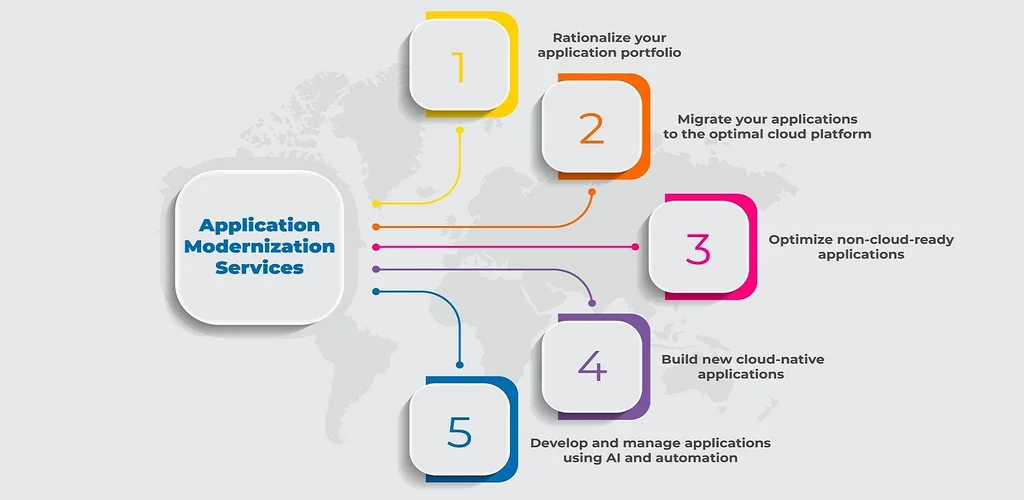Challenges and Solutions in Application Modernization Services in 2023

In today’s digital age, businesses must stay competitive by modernizing their applications. However, the process of application modernization can be complex and challenging, especially for businesses with legacy systems, technical debt, and skill gaps. In this blog, we explore the challenges businesses face during application modernization services, including legacy systems, technical debt, and skill gaps, and provide effective solutions to overcome them. Discover how to successfully modernize your applications and stay competitive in today’s digital landscape.
Challenges in Application Modernization Services
- Legacy Systems: Legacy systems are often outdated and difficult to maintain, making them a major challenge in application modernization. They may not integrate well with modern technologies, making it challenging to upgrade or replace them. Modernizing legacy systems can be daunting as it requires significant re-architecting or complete re-platforming.
- Technical Debt: Technical debt is the cost of maintaining outdated or poorly designed systems. It can accumulate over time, making it difficult to modernize applications without first addressing underlying issues. This can lead to additional costs and delays in the application modernization process.
- Skill Gaps: Application modernization requires a specific set of skills, including knowledge of modern software development practices, cloud computing, and modern software architectures. However, many businesses may not have the necessary skills in-house, which can slow down the modernization process.
Read More; Overcome Challenges of Zoho CRM Customization with Tips and Solutions!
Solutions for Overcoming Challenges in Application Modernization Services
- Legacy Systems: To modernize legacy systems, businesses need to identify areas that need modernization and develop a roadmap for the process. A phased approach can be effective, starting with small changes and gradually building up to more complex changes. Additionally, businesses can consider adopting modern architectures like microservices, which can help to integrate legacy systems with modern ones.
- Technical Debt: Addressing technical debt can be a long-term process, but it is critical to the success of application modernization. Technical debt can be addressed through refactoring, redesigning, and re-architecting systems. Businesses should also consider adopting modern software development practices, such as agile development and continuous integration/continuous deployment (CI/CD).
- Skill Gaps: Hiring or training employees with the necessary skills can help businesses overcome skill gaps. However, partnering with an application modernization services provider that has the expertise and skills needed to complete the modernization process is also an effective solution. An experienced provider can help businesses achieve their modernization goals while minimizing disruption to day-to-day operations.
Additional Solutions for Overcoming Challenges in Application Modernization Services
- Security Concerns: As applications become more modernized, they can become more vulnerable to cyberattacks. To mitigate these risks, businesses should consider adopting a security-first approach when modernizing applications. This involves implementing security measures at every stage of the application modernization process, from development to deployment.
- Cost Management: Application modernization can be an expensive process, especially if businesses are starting with legacy systems. To manage costs, businesses should consider adopting a cloud-first approach. Cloud computing offers a cost-effective way to modernize applications while reducing infrastructure costs and providing greater scalability.
- Change Management: Modernizing applications can bring significant changes to a business’s processes, and it can be challenging to manage these changes effectively. Change management processes can help businesses prepare for the changes and mitigate risks. This involves identifying potential risks, creating a communication plan, and involving stakeholders in the process.
- Data Management: Legacy systems often have outdated data models and may not integrate well with modern data management systems. This can make it challenging to modernize applications that rely on data. To overcome this challenge, businesses should consider adopting modern data management practices, such as data virtualization, which can help to integrate disparate data sources and improve data accessibility.
- User Experience: As applications become more modernized, user experience (UX) becomes a critical consideration. However, legacy systems often have outdated user interfaces and may not provide the level of user experience that modern applications do. To address this challenge, businesses should prioritize UX design and consider conducting user testing to ensure that the new application meets user needs and expectations.
- Integration with Third-Party Systems: Modern applications often rely on third-party systems, such as APIs, to provide functionality. However, legacy systems may not integrate well with these third-party systems, making it difficult to modernize applications. To overcome this challenge, businesses should consider adopting modern integration practices, such as API management and service-oriented architecture (SOA), which can help to integrate legacy systems with modern ones and ensure that third-party systems work seamlessly with the new application.
Conclusion
In conclusion, application modernization services can help businesses stay competitive in today’s digital landscape. However, the modernization process can present challenges, including legacy systems, technical debt, skill gaps, security concerns, cost management, and change management. Businesses can overcome these challenges by developing effective solutions, such as adopting a phased approach, addressing technical debt, partnering with an experienced application modernization services provider, implementing security measures, adopting a cloud-first approach, and implementing change management processes. By taking a strategic and methodical approach, businesses can successfully modernize their applications and stay ahead of the competition.
Read More; Application Development vs Software Development: 9 Big Differences

